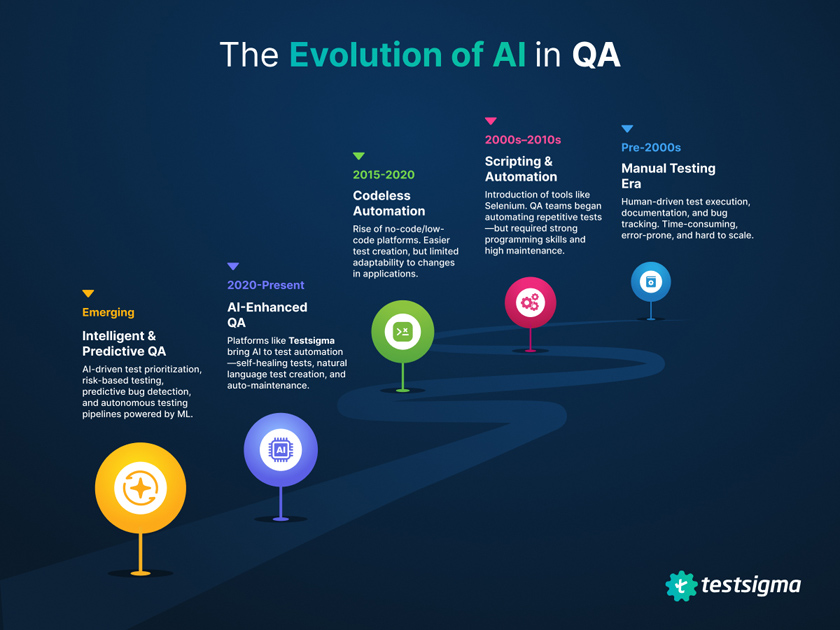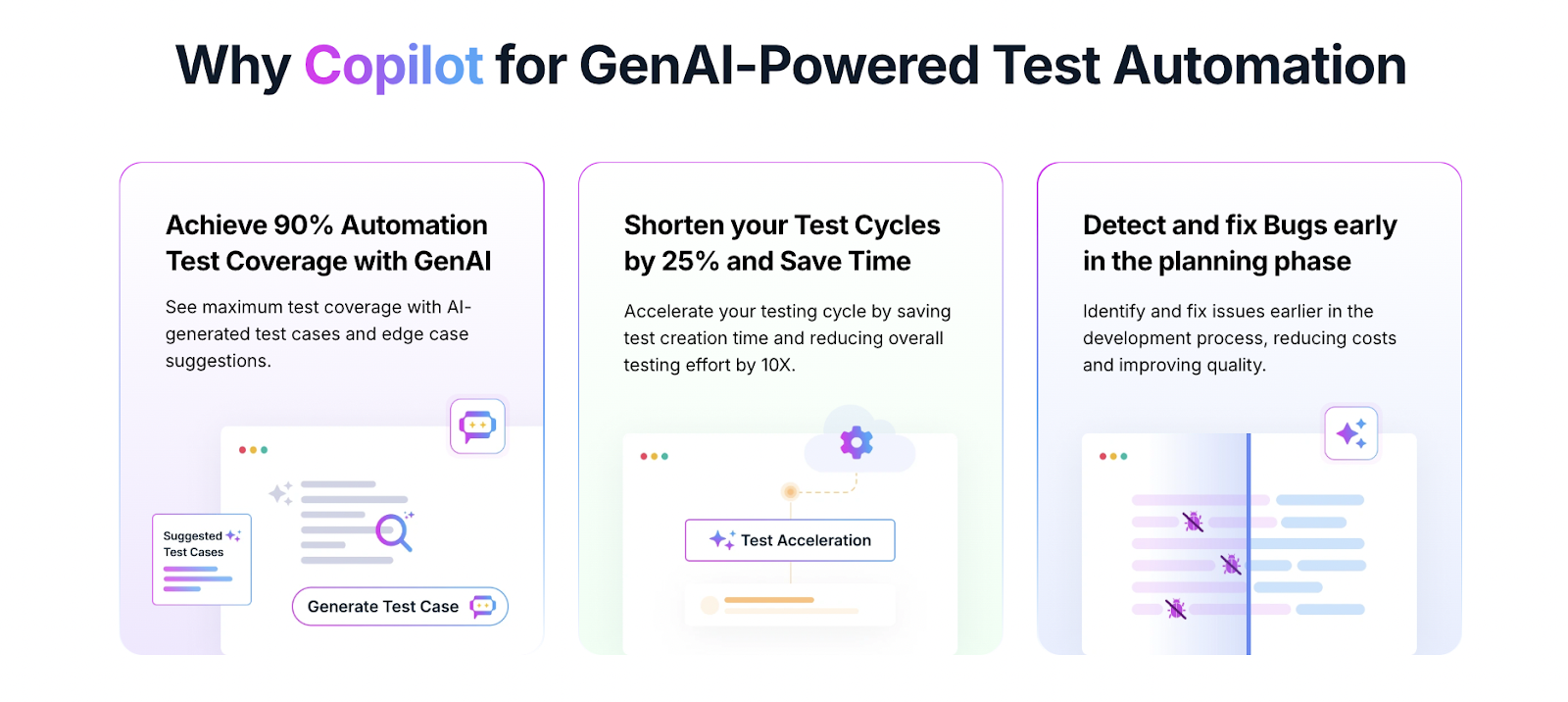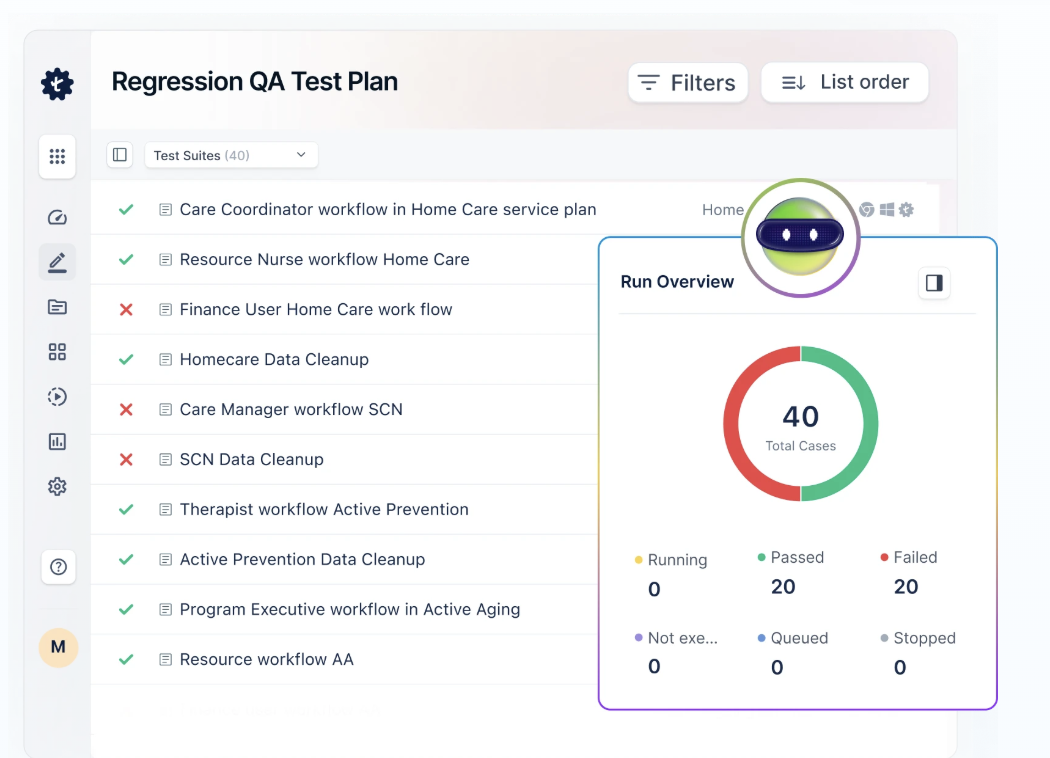Table Of Contents
- 1 Introduction
- 2 What Is AI in Quality Assurance?
- 3 Importance of AI in Quality Assurance (QA)
- 4 Advantages of AI in QA Over Manual Testing
- 5 How To Use AI in Quality Assurance (QA)
- 6 Future of AI in Quality Assurance (QA)
- 7 How Does Testsigma Help with AI in Quality Assurance
- 8 Features Of Testsigma
- 9 FAQ Section
Introduction
Artificial Intelligence is one of the most crucial evolutions. It has revolutionized conventional approaches in many industries, from healthcare to SaaS. AI has shifted to a more advanced approach in software testing, such as automating repetitive tasks, enhancing accuracy, and accelerating release cycles.
However, there has always been a debate about whether AI will replace the human workforce. The answer is No. AI can only help humans achieve faster and more efficient results and cannot replace them. Despite all the myths, AI has been a game changer. In this blog, let’s explore the importance of AI in QA in detail.
What is AI in Quality Assurance?
AI in Quality Assurance refers to integrating artificial intelligence techniques such as machine learning, natural language processing (NLP), computer vision, and Generative AI in software testing lifecycle to improve accuracy, speed, and test coverage.

Unlike traditional test automation that follows predefined scripts, AI-driven QA systems learn from historical test data, predict failure patterns, and adapt test cases dynamically. These systems can identify changes in application UI, generate test scripts from user stories or design files, and even auto-heal broken tests by detecting and updating selectors.
AI agents are also used for intelligent test orchestration, defect triaging, and real-time support via QA chatbots, making the entire QA cycle more efficient.
Importance of AI in Quality Assurance (QA)
44% of companies state that they have integrated AI into their QA processes. Almost half of the companies have reaped benefits from the incorporation of AI in QA. Here are the benefits that you can get by using AI,
- Accelerates release cycles through automated repetitive testing tasks
- Reduces costs by minimizing manual testing efforts.
- Improves risk management with predictive analytics that detect issues earlier.
- Ensures regulatory compliance through consistent, repeatable testing.
- Supports scalability for complex enterprise applications.
Also Read: AI in Software Test Automation
Advantages of AI in QA over Manual Testing
- Self-Healing Capabilities – AI testing tools can analyze application behavior, identify patterns, and adjust tests dynamically, minimizing the need for manual updates when the UI or business logic changes.
- Reduces Regression – Optimizes regression suites by intelligently selecting and prioritizing test cases based on recent code changes and risk analysis. This shortens test cycles and improves release velocity.
- Learn From Historical Data – Machine learning algorithms identify untested or under-tested areas based on historical data, usage analytics, and user journeys, leading to more comprehensive testing.
- Aids In Test Maintenance – AI models can detect redundant test cases, flaky tests, or obsolete steps and optimize or remove them. This leads to a leaner, more maintainable test suite.
Smarter Test Creation – AI testing tools powered by NLP and deep learning can convert natural language requirements, user stories, or design assets, cutting down manual test creation.
How to Use AI in Quality Assurance (QA)
- Identify the project workflows – Understand your project needs and analyze your pain points. Applying AI in the right workflow to reduce QA efforts is the key here.
- Select the right tool – Choose the tool based on your testing goal. If your project takes more time in regression testing and you plan to incorporate AI to make it more efficient, then you can choose a tool that helps maintain that.
- Integrate AI into CI/CD Pipeline – Embed AI into Continuous Integration/Continuous Deployment frameworks to deliver continuous quality feedback throughout development.
- Train QA Teams – Equip teams with the knowledge and skills to collaborate effectively with AI. Human oversight remains critical for interpreting AI outputs and setting strategic priorities.
- Monitor and Optimize – Track key performance indicators such as automation coverage, defect detection accuracy, and healing rates to refine processes continuously.
Future of AI in Quality Assurance (QA)
- Agentic QA Automation
Multi-agent systems will take QA from passive execution to intelligent decision-making. Agents will:
- Plan test strategies
- Generate test cases from evolving systems
- Adapt in real-time
- Collaborate with developers
- Autonomous Testing
From test creation to execution to analysis, AI will handle the full lifecycle with minimal manual input. For example, Test orchestration tools will self-configure test environments based on application architecture, traffic patterns, and test prioritization models.
- Real-Time Quality Intelligence
AI dashboards will shift QA from pass/fail reports to real-time insights:
- Predict feature stability
- Visualize defect hotspots
- Recommend fixes
- Shift From Scripted to Intent-Driven Testing
Natural language prompts, e.g., “test checkout flow on mobile in Firefox,” will become the new standard.
Model interprets intent → executes autonomously → self-validates output
- AI + Synthetic Data for High-Coverage Testing
AI will generate complex, privacy-compliant synthetic datasets to simulate real-world scenarios (like edge cases and load testing) at scale. This is especially critical for sectors like healthcare, finance, and e-commerce, where data is sensitive and behavior is nonlinear.

These developments will lead to more efficient, accurate, and resilient QA practices, supporting organizations as they navigate increasing technological complexity.
How Does Testsigma Help with AI in Quality Assurance

Testsigma integrates AI into quality assurance, not just in buzzwords. From writing test cases in plain English to automatically fixing broken ones, the platform is built for smart, scalable testing.
Whether you aim to shift left, scale across browsers and devices, or reduce flakiness, Testsigma’s AI-first approach helps QA teams move faster, test smarter, and catch issues before they reach production.
Features of Testsigma
- Enhanced Test Coverage Through Intelligence – With NLP-based test creation, reusable components, and support for API + UI tests in one platform, Testsigma enables deep and wide coverage across complete user journeys and edge cases.
- Parallel Testing at Scale – Accelerate your feedback loop by running multiple test cases across browsers and devices simultaneously, drastically reducing test execution time through intelligent workload distribution.
- Extensive Cloud Device Lab – Instantly access a cloud-based lab with 3,000+ real and virtual devices for iOS and Android.
- Self-Healing Capabilities – Detects changes in your application and updates them automatically.
- Cross-Browser Compatibility – Ensure your iOS web apps work seamlessly across all major browsers, including Safari, Chrome, Firefox, and Edge, using real environments in the cloud.
Testsigma introduces Atto, its intelligent Agentic AI, designed to transform how you approach test automation. Atto enhances your QA process through a suite of specialized agents, each built to perform distinct tasks autonomously and intelligently.
- Sprint Planner Agent – Plans your tests as soon as the JIRA sprint starts.
- Generator Agent – Automatically creates test cases from plain natural language with input from prompts, Figma designs, Jira requirements, videos, documents, images, and more.
- Optimizer Agent – Continuously analyzes and refines your test suite, eliminating redundancies and prioritizing high-impact test cases to maintain efficiency and stability.
- Runner Agent – Performs validation of generated tests and allows execution directly within the browser, perfect for fast sanity checks and lightweight test runs.
- Analyzer Agent – Offers deep insights into test failures by correlating them with code changes, empowering teams to identify root causes faster and speed up release cycles.

- Bug Reporter Agent – Captures detailed failure data, including logs, screenshots, and step-by-step actions, making issue reporting seamless and accelerating debugging for developers.
FAQ Section
Software testers should use AI because it automates repetitive tasks, enhances defect detection accuracy, and allows teams to focus on more complex, strategic testing activities. This leads to higher quality software and more efficient QA processes.
AI is transforming Quality Assurance (QA) by streamlining processes, expanding test coverage, and identifying potential defects in advance. Key examples include AI-driven test case creation, automated visual inspections, self-healing test scripts, and predictive analytics for early defect detection.
The levels of AI in QA typically include:
Basic: Reporting and data analytics
Intermediate: Intelligent automation such as script generation and self-healing capabilities
Advanced: Autonomous AI agents capable of independently managing entire testing processes
AI will not replace QA testers. Instead, it will augment their roles by handling routine tasks, enabling testers to focus on strategy, oversight, and high-value test activities that require human judgment.


